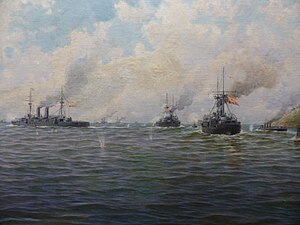
Back Битка при Сантяго де Куба Bulgarian Bitva u Santiaga de Cuba Czech Seeschlacht vor Santiago de Cuba German Batalla naval de Santiago de Cuba Spanish Santiagoko itsas gudua Basque Bataille de Santiago de Cuba French Battaglia navale di Santiago de Cuba Italian サンチャゴ・デ・キューバ海戦 Japanese Slag bij Santiago de Cuba Dutch Bitwa pod Santiago de Cuba Polish
| Battle of Santiago de Cuba | |||||||
|---|---|---|---|---|---|---|---|
| Part of the Spanish–American War | |||||||
 Combate en Santiago de Cuba, Ildefonso Sanz Doménech | |||||||
| |||||||
| Belligerents | |||||||
|
|
| ||||||
| Commanders and leaders | |||||||
|
|
| ||||||
| Strength | |||||||
|
5 battleships 2 armored cruisers 2 armed yachts[1] |
4 armored cruisers 2 destroyers[2] | ||||||
| Casualties and losses | |||||||
|
1 killed 1 wounded[2] |
343 killed 151 wounded 1,889 captured 4 armored cruisers sunk 2 destroyers sunk[2] | ||||||
The Battle of Santiago de Cuba was a decisive naval engagement that occurred on July 3, 1898 between an American fleet, led by William T. Sampson and Winfield Scott Schley, against a Spanish fleet led by Pascual Cervera y Topete, which occurred during the Spanish–American War. The significantly more powerful US Navy squadron, consisting of four battleships and two armored cruisers, decisively defeated an outgunned squadron of the Royal Spanish Navy, consisting of four armored cruisers and two destroyers. All of the Spanish ships were sunk for no American loss. The crushing defeat sealed the American victory in the Cuban theater of the war, ensuring the independence of Cuba from Spanish rule.
Tensions between Spain and the United States worsened over the Spanish conduct during their efforts to quell the Cuban War of Independence, with many Americans being agitated by largely exaggerated reports of Spanish atrocities against the Cubans. In January 1898, fearing the fate of American interests in Cuba from the war, the cruiser USS Maine was dispatched to protect them. Less than a month later, the cruiser exploded while lying at anchor in Havana harbor, killing 266 sailors and inflaming American opinion with Spain being portrayed as the culprit in the American media at the time, despite the fact that the actual cause of the explosion was never conclusively determined. Two months later, war was declared.
The Americans realized that defeating a significant Spanish squadron then stationed in Cuba was vital to ensuring victory in the war. A squadron consisting of six warships were dispatched to ensure success, commanded by both Sampson and Schley, each admiral having his own approach to naval warfare. On July 3, the Spanish squadron steamed out of the harbor to engage with the Americans. The Spanish, totally unprepared and outgunned, made a desperate attempt to reach the open sea with the American battleships and cruisers in hot pursuit. The entire Spanish squadron was sunk with minimal casualties for the Americans, who suffered only two men killed or wounded.
The Americans pulled a total of 1889 Spanish sailors from the water, among them Cervera. The captured Spaniards were treated with respect and care by the Americans, and Cervera gained respect from the American officers for his dignified conduct during and after the battle. Although the battle ensured the American campaign in Cuba would end in a success, tensions soon arose between Sampson and Schley, with various parties in the US Navy and the American public debating over which admiral had made the greater contribution to victory, and the dispute reached the desk of Theodore Roosevelt. The battle remains one of the most significant naval battles in US maritime history.
© MMXXIII Rich X Search. We shall prevail. All rights reserved. Rich X Search